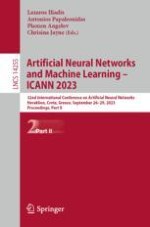2023 | Buch
Artificial Neural Networks and Machine Learning – ICANN 2023
32nd International Conference on Artificial Neural Networks, Heraklion, Crete, Greece, September 26–29, 2023, Proceedings, Part II
herausgegeben von: Lazaros Iliadis, Antonios Papaleonidas, Plamen Angelov, Chrisina Jayne
Verlag: Springer Nature Switzerland
Buchreihe : Lecture Notes in Computer Science
